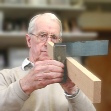

Can it can automatically adjust itself to the thickness of all dimensions within the design size of the sawbench? Will it remain in contact with the material being cut?
Over a range of material thicknesses, does it offer any considerable resistance to insertion of the material?
Is it strong enough to resist blows and strains expected to be found during reasonable operation, adjusting, and handling?
Will its shape effectively protect the operator from flying splinters and broken saw teeth?
Is it made of material that is soft enough so that if it should catch the saw, it will be unlikely to cause tooth breakage, or itself break into fragments?
Is it mounted so that while the blade height and angle are adjusted, its operation will be positive, consistent, and will remain in true alignment with the saw?
Is the mounting adequate in strength to resist any reasonable side thrust or other force tending to throw it out of line?
Is the sawbench supplied with a riving knife to prevent material from nipping the saw.
Is the knife rigid and accurately aligned with the saw?
Is it made from hard tempered steel, or its equivalent? Check the specification.
If the steel is too soft, it can bend and prevent the knife from entering the cut, thus disconcerting the sawyer. If it is too brittle it could be broken by a heavy blow.
For a saw within the ambit of these notes, does the top of the riving knife reach further than 25mm (1in) below the crown of the saw?
Does it have a chamfered leading edge that is rounded? That is, not sharpened?
Is its mounting located below the level of the table? Ie not attached to the finger plate.
Does it rise and fall with the blade? .
Is it secured so that it will not be able to drift, through vibration for example, onto the saw blade? One accident report details how drawing the wood backwards caused a riving knife to be detached and flung into the sawyer's face.
Can it be adjusted so that its distance from the saw teeth does not exceed 8mm (5/16in) at the table level?
Is the thickness of the knife greater than the plate of the saw but less than the kerf?
Is it shaped so that the inner edge conforms as closely as practicable to the contours of the largest saw blade designed to be used on the machine? A knife with a straight edge, whether vertical or inclined, is not satisfactory since the clearance between the saw and the knife progressively increases with the height above the table.
If the saw can be canted, can the knife follow the blade?
Where the blade can cant, is the knife stiff enough to bear the weight of the guard in this position?
Where the guard is supported by the knife, is it as wide and stiff as possible to prevent excessive movement of the guard either due to vibration or a sideways blow?
Is it easy to replace if removed for certain operations?
Is the fence constructed so that it is firmly secured to the table and adjustable so that it does not change its alignment with the saw?
Can the fence-blade parallelism be adjusted?
For saws with tilting tables or tilting arbors check that the blade will remain in a line parallel with the fence, regardless of the angle of the saw with the table.
Can the fence be fitted to either side of the blade?
Are the saw-mounting collars recessed?
Does it vibrate excessively when the standard blade is mounted and run idle at full speed? Some people check by balancing a coin on its edge.
If possible, check the arbor for security and freedom from play.
Check that the belt, pulleys, gears, shafts, and moving parts are guarded.
Does it have switch that can be locked in the off position?
Check that nobody can get a hand underneath the table while the saw is in use.
Is the on/off switch on the machine itself? Can it be operated without reaching over the blade?
If the saw is sold with a plastic push stick, check that it will not fracture to form sharp edges along the break.
If anti-kickback fingers or dogs are fitted, will they provide adequate holding power for all the thicknesses of materials being cut?
Are there any features on the table that could cause the workpiece (or loosened knots) to catch and impede the progress of the cut?
Is it fitted with an electro-magnetic 'No-volt release' control, ie does it have on and off buttons? This system ensures that the saw cannot re-start after a power failure.